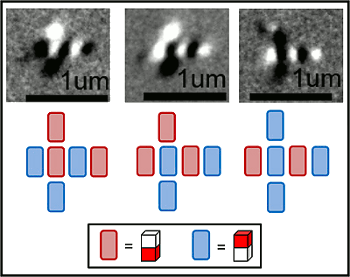
Landauer Limit
July 8, 2011 Our computers dissipate a lot of heat. The CPU of some computers will dissipate more that a hundred watts under peak conditions. According to data supplied by Intel, the Intel Pentium D Processor 960 has a peak power dissipation of 130 Watts. Does it really take that much power to do computation, or is all this heat just a reminder that we still don't know how to build efficient electronics? That sounds like a problem for a physicist to tackle. Computer pioneer and physicist, John von Neumann, was the first to realize from entropy considerations that there must be a finite energy involved in computation, but it wasn't until 1961 that the problem was rigorously tackled by Rolf Landauer of IBM.[1] Landauer reasoned that when a bit of information is irreversibly transformed, as in erasure, or when two bits combine logically to yield just a single bit from the two, some information is lost. Since information and entropy are connected, it's possible to calculate the energy involved in the transformation of a single bit under ideal circumstances. This energy, EL, known as the Landauer limit is given asEL = kT(ln2)where k is the Boltzmann constant, T is the absolute temperature at which the computation takes place, and ln2 is the natural logarithm of two, or about 0.69315. At room temperature, 298.15 K, this calculates out to be just 0.0178 electron volt. For those whose minds aren't calibrated in eV, this is just 2.8519 x 10-21 joule. Although the formal derivation of this formula is more involved, it's easy to see its logical basis. The Boltzmann entropy, S is given as
S = k(lnΩ)where Ω is the the number of ways you can arrange items in a thermodynamic system. When talking about bits of information, there are just two states, thus the ln2 term. One of Maxwell's thermodynamic equations that I discussed in a previous article (Maxwell's Other Equations, April 6, 2011) relates a change in system energy, dU, to a change in entropy,
dU = TdS - PdVOur computers are not usually subjected to a volume change, dV, so we can ignore the PdV term, where P is the pressure. Combining the equations gives us a reason to believe in the Landauer limit. Since a watt is a joule/sec, we should be able to perform at least 1020 bit operations a second for just a watt expenditure. Compare this to the 9.89 megawatts it takes for the RIKEN K Computer to perform 8.2 petaflops; that is, 8.2 x 1015 floating point operations per seconds, as described in a previous article (Special K, June 23, 2011). A floating point operation does take a few bit operations to perform, so to be generous, let's say that these 8.2 petaflops convert to 1020 bit operations per second, so our computing efficiency is about 0.00001%. We're obviously computing under the wrong paradigm! One possible way to increase computational efficiency is to change our mindset from using electrons as current carriers to using electrons as magnets. I mentioned logic operations using the older magnetic bubble technology and the newer spintronic devices in a previous article (Spintronics, February 1, 2011). Electrical engineers at the University of California at Berkeley are doing just that in a study published in Physical Review Letters.[2-3] The UC-Berkeley team, led by Jeffrey Bokor, Professor of Electrical Engineering and Computer Science and scientific director of the Molecular Foundry at Lawrence Berkeley National Laboratory, has created nanomagnetic logic structures that are near the Landauer limit. One caveat is that their computational speed, given by changes in driving magnetic fields, was slow. The slow speed is probably necessary since thermodynamics always requires equilibrium, or quasi-equilibrium, states. The team built a majority logic gate from nanomagnets. In a majority logic gate, the output is determined by a majority "vote" of the inputs. In the example shown in the figure, there are three inputs and one output. Magnetic contrast imaging in the Advanced Light Source at Lawrence Berkeley National Laboratory shows nanomagnets with the north pole facing downwards as bright spots (also represented by the red bars), and nanomagnets with the north pole facing upwards as dark spots (represented by the blue bars). The output is the second bar from the right, and its state is determined by the surrounding bars (top, left and bottom).
 | A majority logic gate formed from six nanomagnets. The output reflects the majority vote of the three input. See text for details. (UC-Berkeley Image). |
References:
- Rolf Landauer, "Irreversibility and heat generation in the computing process," IBM Journal of Research and Development, vol. 5, no. 3 (July 1961), pp. 183-191. A PDF image can be found here.
- Brian Lambson, David Carlton, and Jeffrey Bokor, "Exploring the Thermodynamic Limits of Computation in Integrated Systems: Magnetic Memory, Nanomagnetic Logic, and the Landauer Limit," Physical Review Letters, vol. 107, no. 1 (July 1, 2011), Document No. 010604.
- Robert Sanders, "Magnetic memory and logic could achieve ultimate energy efficiency," University of California - Berkeley Press Release, July 1, 2011.
- Rolf Landauer, "Dissipation in Computation," Physical Review Letters, vol. 53, no. 12 (September 17, 1984), p. 1205.
- Brian Lambson, David Carlton, and Jeffrey Bokor, "Exploring the Thermodynamic Limits of Computation in Integrated Systems: Magnetic Memory, Nanomagnetic Logic, and the Landauer Limit," Physical Review Letters, vol. 107, no. 1 (July 1, 2011), Document No. 010604.